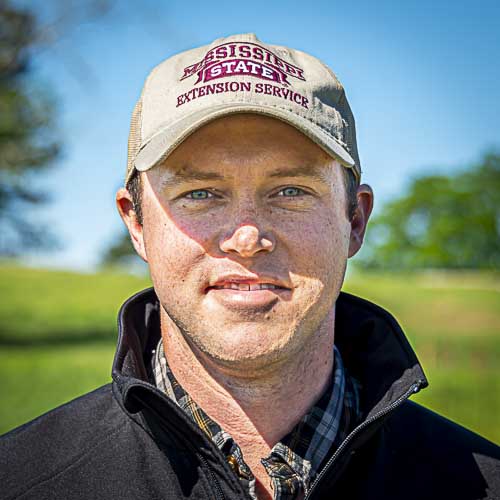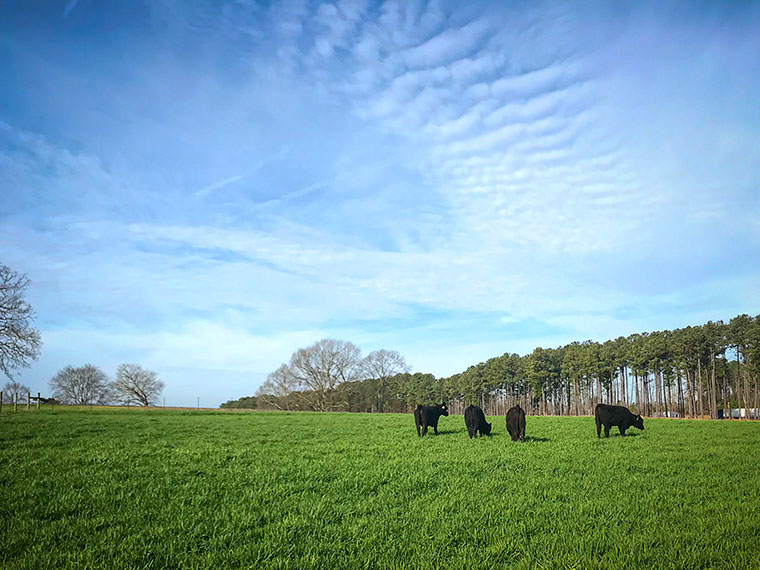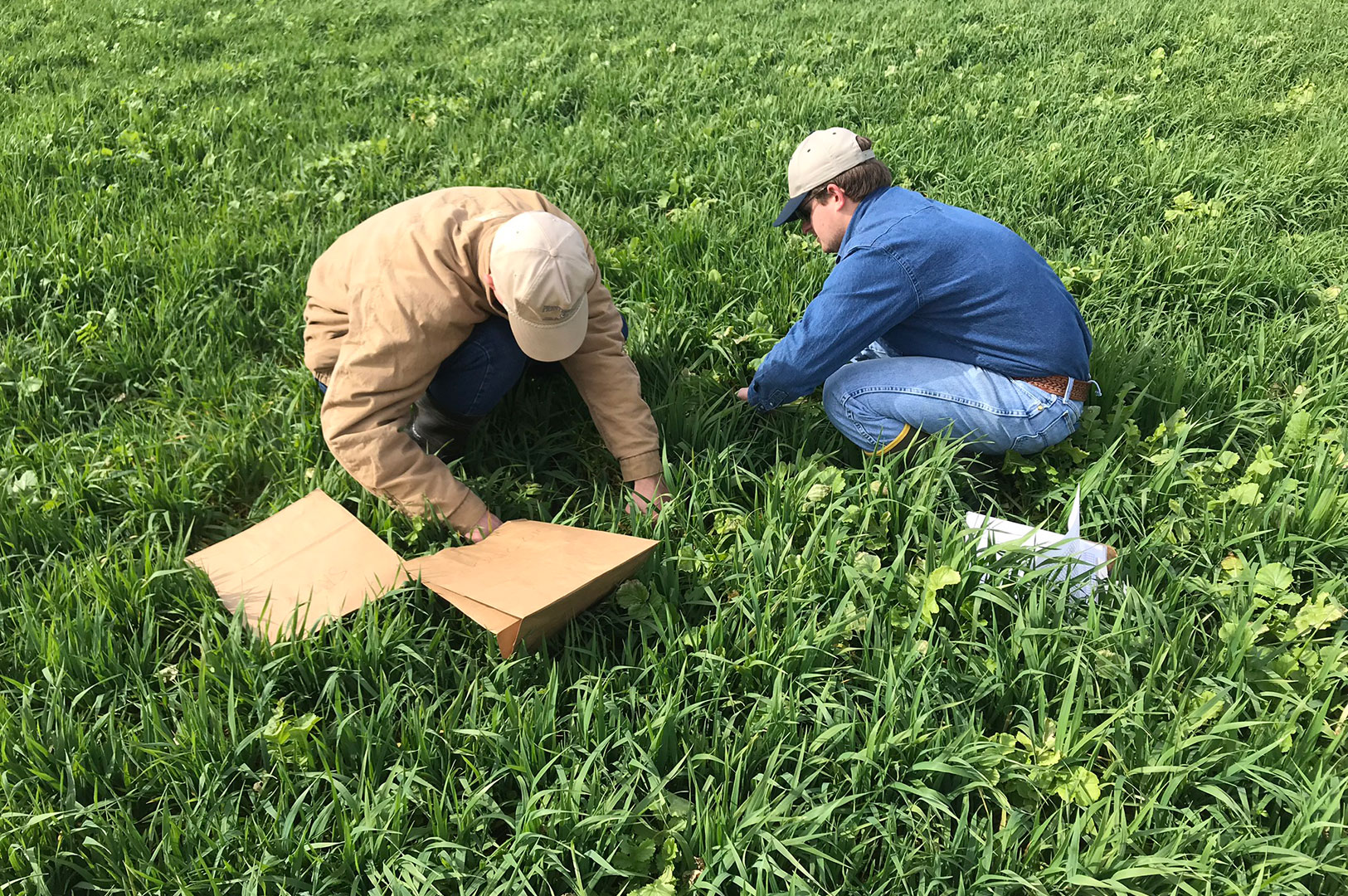The information presented on this page may be dated. It may refer to situations which have changed or people who are no longer affiliated with the university. It is archived as part of Mississippi State University's history.
Oftentimes, growing row crops and raising cattle go hand-in-hand as farmers look to diversify production. Yet, as MAFES scientists and MSU Extension Service specialists think of ways to economically benefit producers while increasing value and productivity of crops and cattle, they wondered if combining a cover crop with grazing cattle could improve both the grazing animals and the producer's bottom line.
Dr. Brett Rushing, associate extension and research professor in plant and soil sciences, and Dr. Josh Maples, assistant professor and extension economist in agricultural economics, analyzed different cover crop species integrated within a livestock grazing system. The goal of the two-year research project was to establish row crops and cover crops that encompassed a variety of species suitable for grazing that led to increased livestock weight gain.
"In Mississippi, we traditionally have row crop producers that are diversified and have beef cattle, but they are not used on the same land base," Rushing explained. "The type of management we are studying will hopefully allow producers to combine the positive attributes of growing cover crops in intensively managed row cropping systems with the ability to produce high animal weight gains through managed grazing on the same landscapes."
Rushing and his team took a unique approach with how to manage the land on which their research was conducted. Rather than tilling the cover crops they planted, the researchers had the cattle graze the cover crops. The team assessed three treatments at the MAFES Coastal Plain Branch Experiment Station in Newton to compare a tilled crop with grazed and non-grazed crops.
"Our research is unique in our treatments and the length of our grazing season," Rushing said. "We are approaching this research with a complete no-till management system with the cover crops and row crops. This approach is specifically designed to assess the impacts of management on soil health."
Starting with oats, crimson clover, and radish as cover crop treatments, the researchers managed these cover crops along with the livestock that would eventually graze the cover crops. The first crops that grew in October of 2019 had a strong growing response, yet due to heavy rains, the crop was delayed. Then the February 2020 freeze affected some of the oat crops that could not withstand the intense weather impacts. Since environmental conditions compressed the grazing season, which kept the research from capitalizing on the grazing window, the overall benefits were not entirely captured within the first two years of the research.
Yet, Rushing and his team were still able to analyze specific improvements of their research. While analyzing the different paddocks, the researchers found that the soil of the grazed crops increased in organic matter.
"Our tilled soils were under one percent of organic matter, where our grazed areas were at one and a half percent," Rushing said. "We are definitely starting to see how grazing benefits organic matter, and with the South's environmental conditions, increase in organic matter by half of a percent in two years is pretty significant."
Rushing noted that there is a big push to have a diverse mix of cover crops, yet that is not always as beneficial as a single species crop. With results from the research, he now feels confident in certain crop treatments he can recommend to producers.
"Usually, there is a diverse mix of what will be planted in cover crops, yet we have found that reducing the number of species makes the mix cheaper and increases net revenue," Rushing said. "We did not see any improvement from an animal or crop perspective in terms of increasing the number of mixes. So, a single species mix for cover crop planting is our best recommendation for benefits of integrated cropping systems."
Over the past two years, extreme environmental and weather conditions altered growing and grazing aspects of this study, yet their research was still able to yield beneficial data.
"We are analyzing data right now, and we have some promising results that we think will support economic justification for implementing these management practices," Rushing said.
With the goal of offsetting costs and increasing revenue, this research also contributes to improving soil health and nutrient management. Maples, who oversaw the economics of the project, noted that the research approach and focus differ from the other cover crop research that is being conducted throughout the nation.
"The idea we could marry two systems like cover crop production and grazing livestock and have economic benefits with an integrative approach is not something that producers are incorporating in this region," Maples said. "So, we approached this research by focusing on the impact the cover crops had on the row crops themselves, and we studied the impact that the crops had on animal weight and then measured the productivity we had for all of those systems."
After the preliminary data analysis, Maples said the initial findings suggest some crops were more economically beneficial than other mixed species cover crops. This result has shown the researchers what kind of cover crop mixes will be more successful than others, and therefore, has provided data to recommend to producers what will and won't be most profitable with an integrated row and cover crop system.
The two-year project has ended; however, the scientists are excited to start the next phase of the study.
"This research is relevant, and we are getting to apply it directly to what the producers ask us every day," Maples said. "Studying these crops for a longer term, along with the market and production system changes, will provide more applicable results that can help producers maintain successful cropping systems."
Long-term research and studies will provide answers on how to establish and manage integrated cattle and cover crops systems from both an economic and agronomic standpoint. Maples explained that with continually changing markets and weather conditions, research that focuses on economic and agronomic benefits, like this, must be studied in a long-term setting.
"The initial results are practical and useful, and we are excited for longer-term studies to find the answer for what kind of crops can be most profitable for certain management goals and outcomes," Maples said.
New research projects will begin in the Spring of 2022 and will be conducted on other MAFES branches, including the Prairie Research Unit in Prairie and the Brown Loam Branch Experiment Station in Learned. The scientists will focus on cereal rye as the cover crop treatment, along with evaluating soil benefits through a biological lens. The analysis will assess chemical, biological, and physical benefits like organic matter, carbon sequestration, and available phosphorus throughout the cover crop growing season. By continuing the research, it is the team's goal to provide impacts to improve producer's bottom line.
"This research impacts a diverse range of people because of the different components of the project. We focus on cash crops, soil health, economics, animal nutrition, and cover crop components that impact several sectors of the industry," Rushing said.
This research is funded by Mississippi Agricultural and Forestry Experiment Station's Special Research Initiative. Dr. Rocky Lemus, MSU Extension and MAFES research professor, collaborated on this study.
We focus on cash crops, soil health, economics, animal nutrition, and cover cop components that impact several sectors of the industry.
Dr. Brett Rushing
Behind the Science

Brett Rushing
Associate Extension/ Research Professor
Education: B.S., Biology, Jacksonville State University; M.S., Ph.D., Agronomy, Mississippi State University
Years At MSU: 12
Focus: Forages, biofuel crops, and conservation species
Passion At Work: My split appointment allows me to conduct applied research and deliver the results of our work directly to producers.

Josh Maples
Assistant Professor
Education: B.S., M.S., Agricultural Economics, Mississippi State University; Ph.D., Agricultural Economics, Oklahoma State University
Years At MSU: 5
Focus: Livestock and forage economics
Passion At Work: I enjoy studying the complexities of livestock markets and the economics of forage production and helping producers understand the tools and information available to manage risk and make informed decisions.


